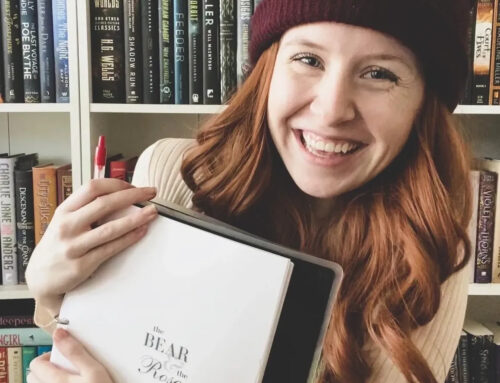An interview with Eddie Wright, author of the novel Broken Bulbs, now being turned into a graphic novel called “Tyranny of the Muse,” backed by a Kickstarter campaign.
About:
Tyranny of the Muse by writer Eddie Wright and artist Jesse Balmer is a comic book series about a sad-sack, inspiration-addict, who is obsessed with the idea of nothingness.
When a mysterious, chain-smoking muse named Bonnie offers her unique assistance to Frank Fisher (our sad-sack hero), by injecting literal seeds of inspiration directly into his brain, the couple find themselves on a twisted, frantic, chaotic, fast-paced and surreal path littered with addiction, self-loathing, vindictive mailmen, infected wounds and angry hamsters. Through it all, they rely only on each other as they work through Frank’s strangely familiar screenplay in their search for the ever-elusive somethingness while avoiding the terrifying curse of nothingness. Tyranny of the Muse combines the storytelling of Philip K. Dick, David Lynch, William S. Burroughs and David Cronenberg with the alternative art style of Charles Burns, R. Crumb and Paul Pope. Tyranny of the Muse is based on Wright’s critically-acclaimed cult novella Broken Bulbs. This Kickstarter will fund the first volume in a multi-volume series.

Self-Publishing Review: So what’s the project? It’s called “Tyranny of the Muse” but it’s based on your novel “Broken Bulbs” – are the two different thematically or plotwise? Why not call it “Broken Bulbs”?
Eddie Wright: Tyranny of the Muse is a multi-volume adaptation/expansion of my novella Broken Bulbs. The story is about a failing artist who gets addicted to inspiration after meeting–and basically falling in love with–a chain-smoking muse. She helps him overcome his self-doubt and feelings of worthlessness while working through his quasi-auto-biographical screenplay. I decided to give the comic a different title because the story is expanded and I want to be able to continue it without being locked into anything. Broken Bulbs tells a very specific story about Frank Fisher, our artist and Bonnie, his muse. Tyranny will initially adapt the book, then expand. Vol. 1 will tell what is essentially act one of Broken Bulbs, then I plan to continue the story for as long as possible. So it’s growing beyond Broken Bulbs, particularly when it comes to Bonnie’s background.
SPR: What was the process for adapting your novel? It’s already pretty cinematic (it’s part screenplay) but what was the process for storyboarding the book?
EW: Adapting the book was pretty easy. It started life as a screenplay, which is why Frank is a struggling screenwriter, so the story is very dialogue heavy. But the book is first person, the comic is not. There are a few moments of narration, but I eliminated most of it. I don’t want the comic to be loaded with captions so I had to reconfigure scenes and dialogue to make sure that the emotions and feelings came through. The trickiest part of the process has been communicating my intentions to Jesse, the artist on the book. But I’ve always felt the story was very visual and Jesse is certainly proving me right, he’s nailing it.
SPR: Were you approached by the artist, or was this an idea you had and then looked for an illustrator? Did you then work together?
EW: I’ve wanted to adapt Broken Bulbs for a while and I put out many calls for an artist on Twitter, Facebook and my blog, but had no luck. Until one day a reader saw one of my tweets and put me in touch with Jesse Balmer, a great artist from San Francisco. I checked out his work, told him my plans and offered him the gig. He dug it and that was that.
The process started with a lot of discussions about character designs and the overall look and feel. I really wanted him to capture the characters. We went back and forth over and over again, I sent him pics of actors who I imagined as Frank and Bonnie so he could use something as an example. Something that proved to be important was actually meeting and sitting down in person and going through Jesse’s sketchbook and talking it all through. I have very specific images in my mind but it’s important for me to allow him to bring his own style to the project as well. The book is about creativity and inspiration, so how could I ever limit his?
SPR: I know very little about the world of self-published graphic novels. Have you looked into the scene, ways of promoting it in comic circles?
EW: Something I’ve learned immediately about comics is self-publishing is not a dirty word. Creators self-publish as a way in and that is completely acceptable. Literature is snobby and closed off in certain circles. Thankfully that type of thinking is going away (thanks to sites like this) but comics is and has been very supportive in that regard. Perhaps the form is already so marginalized that the mainstream is less mainstream than mainstream lit. I don’t know. I’m not sure, but from what I’ve seen, in comics, good is good.
SPR: How’s the Kickstarter process going? What are you doing to promote it – any tips for getting the word out?
EW: Kickstarter is nerve-wracking and exciting and I really hope it works. I’m tweeting and facebooking and tumbling and sending messages to other creators and reaching out to whomever I can for help. Thankfully I have Jesse to lighten the load a bit, but it’s a lot of begging. One tip I have is to swallow your pride and don’t be afraid to ask for help. A service like Kickstarter is all about support. Use it to create a support group. People want to help. Don’t be afraid to ask for it.
Get an Editorial Review | Get Amazon Sales & Reviews | Get Edited | Get Beta Readers | Enter the SPR Book Awards | Other Marketing Services
























Leave A Comment